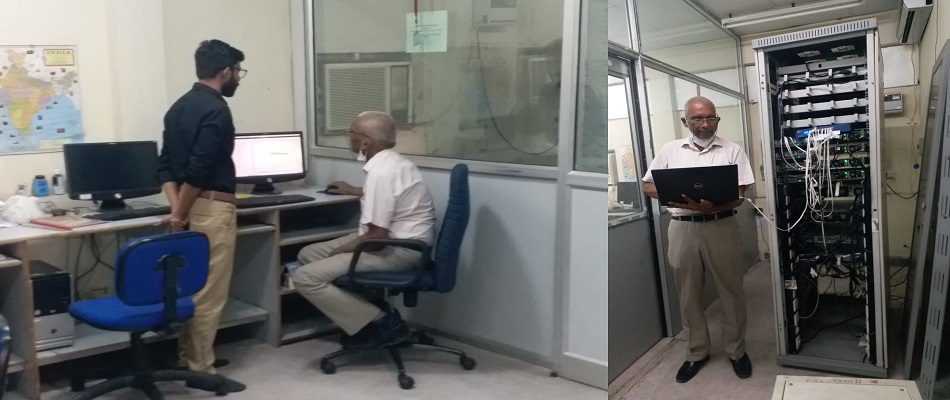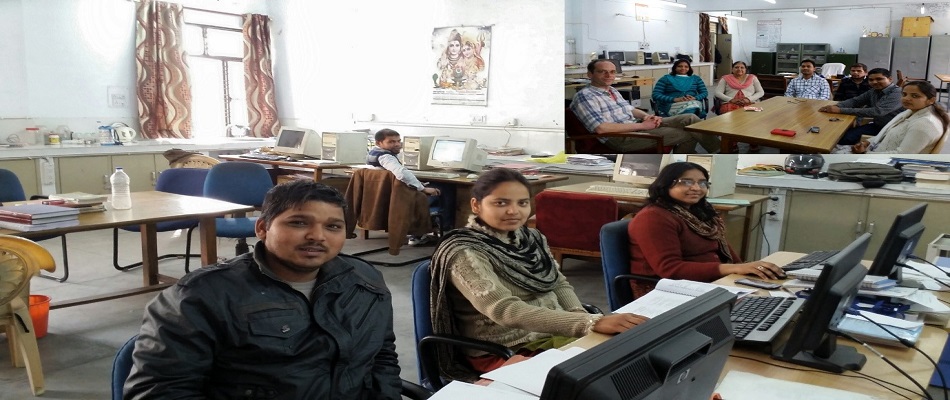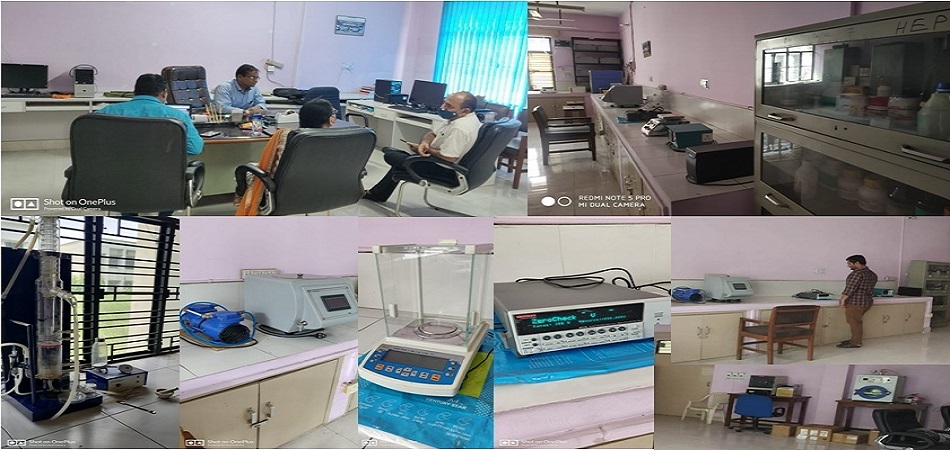Present details of departmental infrastructural facilities which regard to
- Seminar library: Around 500 books are available for student and faculties.
- The department is equipped with modern facilities like computers linked with internet for students as well as teachers. We are thus in close and quick contact of latest computer program activities all around us.
Research Laboratories
1. High performance computational (HPC) Lab :

The vision behind first-principles condensed matter theory is to uncover all properties of a material to its underlying electronic structure including vibrational, thermodynamical etc. In principle this vision is embedded in density functional theory (DFT), which allows one to replace the complex many-body wave
function by the electron density as the basic quantity of interest. Most of the study is limited to the ground state which allows to study structure, bonding, vibrational properties of solids, molecules, defects in solids, and nanoscale systems. Many-body perturbation theory allows one to also tackle the one-particle
and two-particle excitations, i.e. the band structure and the optical properties. The challenge is to apply DFT to systems of ever increasing complexity.
In my research group, we apply DFT to a variety of interesting novel materials systems. We look for experimental data/collaboration with experimentalists to understand these materials properties, sometimes predicting new materials with desirable properties. Further sometimes, we trying to solve the puzzles posed by
experimentalist in terms of characterisation techniques, such as identifying defects are responsible for specific experimental signatures in photoluminescence, etc.
We mostly use most of the time Vienna Ab initio Simulation Package (VASP) however our group is also acquainted with the full-potential linearised augmented plane wave (FP-LAPW) and Full potential Local Orbital method (FPLO). Moreover any full potential methods are computational demanding. To study phonons, we also
use density functional perturbation theory implemented in phonopy.
Some of our past and current research interests include:
Ternary semiconductor nitrides: Semiconducting nitrides such as GaN,InN, AlN which is basis for several electronic devices including laser technology. We have studied a number of number of semiconductor alloys which is related to III-V and II-VI compounds. In fact, family of III-V and II-VI semiconductor,
in which the group-V/VI elements are replaced by N-anion. These have interesting new properties because of the lower symmetry and the more complex defect physics and the possibility of disorder of the two cations II and IV on their respective sublattices. We study their electronic band structure, defects,
thermodynamical properties. (Journal of Physics and Chemistry of Solids 86 (2015) 101-107)
Layered photovoltaics: Photovoltaics is one of the fastest growing renewable energy technologies. The potential is enormous, and an increased installation of solar cells is expected supported by continuous improvement in performance and reduction in cost. Thin film solar cells have the advantage that
the active material can be very thin since sunlight absorption is effective. The solar cell group at the division for Solid State Electronics is working with fundamental understanding and development of efficient solar cells at low cost based on thin film technology.
The solar cells are made from the established semiconductor Cu(In,Ga)Se2 (CIGS) where device efficiencies exceeding 20% have been achieved and the less explored material Cu2ZnSnS4 (CZTS) where the advantage is that only very abundant elements are used. The research group has a fully equipped lab for cells and
modules in the Ångström clean room. More information can be found. (Physical Review B 94 235206 2016)
Layered ultra-thin materials : Graphene is one atom thin layer of carbon in a honeycomb network. Other layered materials with weak interactions between the layers are transition metal dichalcogenides, such as MoS2, WSe2. These materials are technologically very important. Some of the intriguing properties of
these materials, such as the spin-orbit, strain and electric field effects on their band structure in single or few-layer form. We found interesting blue shifts in the energy band gap of a monolayer compared to bulk materials, which find their origin in the reduced screening in a 2D system.
2D Anode Materials: Our group is also interested in to find suitability of anode materials for two dimensional Li-ion batteries The DFT based calculation suggests that that adsorption of Li atoms at hollow site of germanene is energetically favourable. The Bader charge analysis indicate that the transfer of
charge occur from adsorbed Li atoms to 2D germanene sheet, suggesting formation of ionic bond between Li and Ge atom. We utilised the climbing image nudged elastic band (CI_NEB) method to analyse the energy barrier for Li ion diffusion along the surface and through the germanene sheet. In order to to record the
stability at room temperature, we have performed ab-initio molecular dynamics (AMID) calculation at 300K also. (Computational Condensed Matter 16 (2018)e00314; 14 (2018) 84-88.
Magnetism in 2D ultra thin film : Two dimensional (2D) novel materials are utilised in the several fields including opto electronic devices, renewable energy resources, data storage and many more. The magnetism in 2D matrix can be produced by embedding transition metals (TMs) at mono vacancy/double vacancy site.
Microscopic analysis of DFT calculation for germanene suggest that TM embedded into MV and DV , Ge-p orbital hybrididizes strongly with the d -orbital of TM and renders the materials semi-metallic. However the effects the effects of the s-orbital is negligible in hybridisation. The semi-metallic feature is an
advantage for device performance shows high electron mobility. Mn embedded germanene shows largest value of magnetic moment while Sc and Ti shows non magnetic behaviour (J.Phys. D: App. Phys. 51 (2018) 225006).
2D Heterostructure a promising photo absorber : 2D materials exhibit physical and chemical properties however magnetism is still missing property in the current lineup. Therefore exploration of 2D spontaneous magnetic
crystal is of great importance. In this regards, a new type single layered magnetic chalcogen phosphates materials (MnPSe3) of MPX3 (X=TMs) belong to weak interlayer vdW is supposed to be a promising photo absorber. Little known about the construction and regulation of the vdW structures assembled by monolayerMnPSe3/WX2(S,Se and Te).
Our calculation results demonstrate that when monolayer WS2 is brought in contact with MnPSe3, interface coupling results in heterogeneous properties for heterostructure, distinguishing it from individual constituents. Journal of Physics Condensed Matter 32 (31) 315501(2020)
Hydrogen storage energy materials and its defect properties : Hydrogen may become a prime source for next generation may be due to its smaller size, non toxic nature and easily availability. However, there many experimental and theoretical groups are looking for new promising hydrogen storage material. The layer transition metal
dichalcogenides (TMDC) like MX2 (M= transition metal like Nb, Mo and W; X= S, Se and Te) in bulk phases becomes on of the potential candidate for hydrogen storage due to large interstitial space available between interlayer. International Journal of Hydrogen Energy 43, 2316(2018
2D materials as promising sensor : In recent years, 2D materials have been used as the response material within sensor devices because of their excellent properties. Gas sensors measure the gaseous molecules present in an area. The most common types are used to detect common hazardous gases, such as carbon monoxide in the home,
or greenhouse gases in the environment. However, gas sensors are more varied than this and can be used to measure a wide range of dangerous gaseous chemicals, including Co, No2, H2S, NH3 etc .
As many will be aware, a lot of the other unimolecular 2D materials such as stanene and borophiene etc. are not at a level to be used in a functional device, but they have been theorised through computational studies. Computational Condensed Matter 22 e00436 (2020).
Google site: https://scholar.google.co.in/citations?user=uJlsbmkAAAAJ&hl=en
2. Vibrational Spectroscopy Lab :

Vibrational Spectroscopy Research Group at Applied Physics Department, M.J.P. Rohilkhand University, Bareilly is led by Prof. Archana Gupta. We have a variety of research interests with a focus on vibrational spectroscopy techniques, Raman and infrared. Vibrational spectroscopy is used to study a very wide range of sample types and can
be carried out from a simple identification test to an in-depth, full spectrum, qualitative and quantitative analysis. Samples may be examined either in bulk or in microscopic amounts over a wide range of temperatures and physical states (e.g., gases, liquids, latexes, powders, films, fibres, or as a surface or embedded layer). Vibrational
spectroscopy has a very broad range of applications and provides solutions to a host of important and challenging analytical problems. The laboratory supports analysis of vibrational spectral fingerprints mainly from polymers, non-linear optical (NLO) and pharmaceutical samples. The experimental spectroscopic data is analyzed theoretically
by Density Functional Theory (DFT) method.
The development of NLO materials for device applications requires a multidisciplinary effort involving both theoretical and experimental studies. Theoretical calculations offer a quick and inexpensive way of predicting the NLO properties of the materials. Quantum chemical calculations have made an important contribution to the understanding
of the electronic polarization underlying the molecular NLO processes and the establishment of structure-property relationship. NLO behavior is investigated by the determination of the electric dipole moment, mean polarizability, anisotropy of polarizability, first and second order hyperpolarizabilities. These are important parameters to check
the real time application of NLO compound and can be practically realized in experiments.
During the pre-formulation stage of drug development, a great number of characterization methodologies can be employed and each has its associated utility and function for the physical characterization of drug substance. Structure and spectroscopic features of pharmaceuticals are studied along with reactivity parameters using experimental
techniques and tools derived from quantum chemical calculations. The global reactivity indices such as electron affinity, ionization energy, chemical potential, electro negativity, hardness and softness are calculated for interpreting and predicting diverse aspects of chemical bonding and reaction mechanism whereas Fukui functions, local
softness and local philicity indices are employed to probe site selectivity of molecules. Estimation of biological effects, toxic/side effects are made on the basis of prediction of activity spectra for substances (PASS) prediction results and their analysis by Pharma Expert software. Docking simulations are done in order to get an insight
into ligand–receptor interactions and to find the best orientation of the ligand which would form a complex with overall minimum energy.
3. Experimental High Energy Physics & Nano science and Technology Lab :

3.1 Experimental High Energy Physics
Nuclear emulsion technique is a versatile instrument to detect charge particles. It is not only able to counting the charge particles but also provide information about mass energies and moment of particles and their modes of interactions. High energy nucleus-nucleus interactions at relativistic energies provide us nuclear matter under extreme conditions of temperature, pressure and density, which may cause some new nuclear phenomenon like nuclear shock waves, anomalous.
One of the most exciting motivations of the study of mechanism of relativistic high energy nucleus nu-cleus interaction is to find out possibility of nuclear equation of state at extremely high densities, tem-peratures and pressures as well as the search for the the phase transition nuclear matter in to some ab-normal super dense state of matter like pion condensates, density isomers and quark gluon plasma.
Further, the study of such a state would help us in answering some of the cosmological questions be-cause formation of quark gluon plasma is visualized to take place in collapsing states. Hence the creation of fluctuation in the early universe could be explained by studying the formation and properties of quark gluon plasma. It is reported that the density of nuclear matter becomes 3 to 4 times during these relativ-istic collision.
Therefore if they exist at these densities, pion condensation and quark matter may play a key role in investing the properties of these highly compressed stellar objects. The relativistic heavy ion collisions probably provide the only means of simulating these extreme conditions of temperature, pres-sure and density in the laboratory.
Therefore, we are in the process of through study of the mechanism of multiparticle production in high energy nucleus-nucleus interaction at relativistic energies.
3.2 Nanoscience and Technology
Nanoscience and nanotechnology are at the forefront of modern research. The fast growing economy in this area requires experts who have an outstanding knowledge of nanoscience in combination with the skills to apply this knowledge in new products.
Nanoscience refers to the study, manipulation and engineering of matter, particles and structures on the nanometer scale (one millionth of a millimeter, the scale of atoms and molecules). Important properties of materials, such as the electrical, optical, thermal and mechanical properties,
are determined by the way molecules and atoms assemble on the nanoscale into larger structures. Moreover, in nanometer size structures these properties often different then on macroscale, because quantum mechanical effects become important.
Nanotechnology is the application of nanoscience leading to the use of new nanomaterials and nanosize components in useful products. Nanotechnology will eventually provide us with the ability to design custom-made materials and products with new enhanced properties, new nanoelectronics
components, new types of “smart” medicines and sensors, and even interfaces between electronics and biological systems.
Materials Science and Engineering is at the heart of Nanotechnology whether it leads to advances in electronics and quantum computing, bioengineering, mechanical engineering, or other disciplines.
So we are in the process of synthesizing the nanomaterials by some chemical technique and estimat-ing the electrical, optical, optoelectrical and magnetic properties of synthesized nano materials.